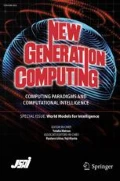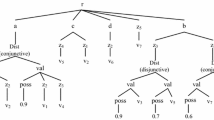Abstract
In this paper we present a fuzzy variant of the XPath query language for the flexible information retrieval on XML documents. Our main purpose is to provide a repertoire of operators that offer the possibility of managing satisfaction degrees by adding structural constraints and fuzzy operators inside conditions, in order to produce a ranked sorted list of answers according to user’s preferences when composing queries. By using the FLOPER system designed in our research group, our proposal has been implemented with a fuzzy logic language to take profit of the clear synergies between both target and source fuzzy languages.
Similar content being viewed by others
References
Almendros-Jiménez, J. M., “An Encoding of XQuery in Prolog,” in Proc of the Sixth International XML Database Symposium XSym’09, Lecture Notes in Computer Science, 5679, Springer, Heidelberg, Germany, pp. 145–155, 2009.
Almendros-Jiménez, J. M., Becerra-Terón, A. and Enciso-Baños, F. J., “Querying XML documents in logic programming,” Theory and Practice of Logic Programming, 8(3), pp. 323–361, 2008.
Almendros-Jiménez, J. M., Luna Tedesqui, A. and Moreno, G. “Annotating ‘fuzzy chance degrees’ when debugging xpath queries,” in Advances in Computational Intelligence, Springer, pp. 300–311, 2013.
Almendros-Jiménez, J. M., Luna, A. and Moreno, G., “Fuzzy Logic Programming for Implementing a Flexible XPath-based Query Language,” Electr. Notes Theor. Comput. Sci., 282, pp. 3–18, 2012.
Almendros-Jiménez, J. M., Luna Tedesqui, A. and Moreno, G., “Dynamic filtering of ranked answers when evaluating fuzzy xpath queries,” in Rough Sets and Current Trends in Computing - 9th International Conference, RSCTC 2014, Granada and Madrid, Spain, July 9-13, 2014, Lecture Notes in Computer Science, 8536, Springer, pp. 319–330, 2014.
Almendros-Jiménez, J. M., Luna, A. and Moreno, G., “A Flexible XPath-based Query Language Implemented with Fuzzy Logic Programming,” in Proc. of 5th International Symposium on Rules: Research Based, Industry Focused, RuleML’11. Barcelona, Spain, July 19–21, Lecture Notes in Computer Science 6826, Springer Verlag, Heidelberg, Germany, pp. 186–193, 2011.
Amer-Yahia, S., Cho, S. and Srivastava, D., “Tree pattern relaxation,” in Advances in Database Technology–EDBT 2002, Springer, pp. 496–513, 2002.
Amer-Yahia, S., Koudas, N., Marian, A., Srivastava, D. and Toman, D., “Structure and content scoring for xml,” in Proc of the 31st international conference on Very large data bases, VLDB Endowment, pp. 361–372, 2005.
Amer-Yahia, S., Lakshmanan, L.V.S. and Pandit, S., “FleXPath: flexible structure and full-text querying for XML,” in Proc of the 2004 ACM SIGMOD international conference on Management of data, ACM, pp. 83–94, 2004.
Baldwin, J. F., Martin, T. P. and Pilsworth, B. W., Fril- Fuzzy and Evidential Reasoning in Artificial Intelligence, John Wiley & Sons, Inc., 1995.
Berglund, A., Boag, S., Chamberlin, D., Fernandez, M. F., Kay, M., Robie, J. and Siméon, J., XML path language (XPath) 2.0., W3C, 2010.
Bosc, P. and Pivert, O., “SQLf: a relational database language for fuzzy querying,” Fuzzy Systems, IEEE Transactions on, 3(1), pp. 1–17, 1995.
Buche, P., Dibie-Barthélemy, J., Haemmerlé O. and Hignette, G., “Fuzzy semantic tagging and flexible querying of XML documents extracted from the Web,” Journal of Intelligent Information Systems, 26(1), pp. 25–40, 2006.
Buche, P., Dibie-Barthélemy, J. and Wattez, F., “Approximate querying of XML fuzzy data,” Flexible Query Answering Systems, pp. 26–38, 2006.
Buckles, B. P. and Petry, F. E., “A fuzzy representation of data for relational databases,” Fuzzy Sets and Systems, 7(3), pp. 213–226, 1982.
Buckles, B. P. and Petry, F. E. and Sachar, H. S., “A domain calculus for fuzzy relational databases,” Fuzzy Sets and Systems, 29(3), pp. 327–340, 1989.
Campi, A., Damiani, E., Guinea, S., Marrara, S., Pasi, G. and Spoletini, P., “A fuzzy extension of the XPath query language,” Journal of Intelligent Information Systems, 33(3), pp. 285–305, 2009.
Case, P., Dyck, M., Holstege, M., Amer-Yahia, S., Botev, C., Buxton, S., Doerre, J., Melton, J., Rys, M. and Shanmugasundaram, J., XQuery and XPath Full Text 1.0, W3C, 2011.
Damiani, E., Marrara, S. and Pasi, G., “FuzzyXPath: Using fuzzy logic and IR features to approximately query XML documents,” Foundations of Fuzzy Logic and Soft Computing, pp. 199–208, 2007.
Damiani, E., Marrara, S. and Pasi, G., “A flexible extension of XPath to improve XML querying,” in Proc of the 31st annual international ACM SIGIR conference on Research and development in information retrieval, ACM, pp. 849–850, 2008.
Fazzinga, B., Flesca, S. and Furfaro, F., “On the expressiveness of generalization rules for XPath query relaxation,” in Proc. of the Fourteenth International Database Engineering & Applications Symposium, ACM, pp. 157–168, 2010.
Fazzinga, B., Flesca, S. and Pugliese, A., “Top-k Answers to Fuzzy XPath Queries,” in Database and Expert Systems Applications, Springer, pp. 822–829, 2009.
Fazzinga, B., Flesca, S. and Furfaro, F., “XPath query relaxation through rewriting rules,” Knowledge and Data Engineering, IEEE Transactions on, 23(10), pp. 1583–1600, 2011.
Fazzinga, B., Flesca, S. and Pugliese, A., “Retrieving xml data from heterogeneous sources through vague querying,” ACM Transactions on Internet Technology (TOIT), 9(2), 7, 2009.
Fazzinga, B., Flesca, S. and Pugliese, A., “Top-k approximate answers to xpath queries with negation,” IEEE Trans. Knowl. Data Eng., 26(10), pp. 2561–2573, 2014.
Formica, A., “Semantic Web search based on rough sets and Fuzzy Formal Concept Analysis,” Knowledge-Based Systems, pp. 40–47, 2011.
Gaurav, A. and Alhajj, R., “Incorporating fuzziness in XML and mapping fuzzy relational data into fuzzy XML” in Proc. of the 2006 ACM symposium on Applied computing, ACM, pp. 456–460, 2006.
Gursky, P., Horvath, T., Novotny, R., Vanekova, V. and Vojtas, P., “UPRE: User preference based search system,” in Web Intelligence, 2006, WI 2006, IEEE/WIC/ACM International Conference on, IEEE, pp. 841–844, 2006.
Herrera-Viedma E. and Pasi, G., “Fuzzy approaches to access information on the Web: recent developments and research trends” in Proc. International Conference on Fuzzy Logic and Technology (EUSFLAT 2003), pp. 25–31, 2003.
Ishizuka, M. and Kanai, N., “Prolog-ELF Incorporating Fuzzy Logic,” in Proc. of the 9th Int. Joint Conference on Artificial Intelligence, IJCAI’85(Joshi, A. K. ed,), Morgan Kaufmann, pp. 701–703. 1985.
Julián, P., Medina, J., Morcillo, P.J., Moreno, G. and Ojeda-Aciego, M., “An unfolding-based preprocess for reinforcing thresholds in fuzzy tabulation,” in Proc. IWANN Part 1 (Rojas, I., Joya Caparrós, G. and Cabestany, J. eds.), Lecture Notes in Computer Science, 7902, Springer, pp. 647–655, 2013.
Julián, P., Medina, J., Moreno, G. and Ojeda, M., “Efficient thresholded tabulation for fuzzy query answering,” Studies in Fuzziness and Soft Computing (Foundations of Reasoning under Uncertainty), 249, pp. 125–141, 2010.
Julián, P., Moreno, G. and Penabad, J., “On the declarative semantics of multiadjoint logic programs,” in Bio-Inspired Systems: Computational and Ambient Intelligence, 10th International Work-Conference on Artificial Neural Networks, IWANN’09, Salamanca, Spain, June 10-12, 2009, Proc, Part I, (Cabestany J. et al. eds.), Lecture Notes in Computer Science, 5517, Springer, pp. 253–260, 2009.
Kraft, D. H., Pasi, G. and Bordogna, G., “Vagueness and uncertainty in information retrieval: how can fuzzy sets help?” in Proc. of the 2006 international workshop on Research issues in digital libraries, ACM, Article No. 3, 2006.
Lee, R. C. T., “Fuzzy Logic and the Resolution Principle” Journal of the ACM, 19(1), pp. 119–129, 1972.
Li, H, Aghili, S. A., Agrawal, D. and El Abbadi, A., “Flux: Fuzzy content and structure matching of xml range queries,” in Proc. of the 15th international conference on World Wide Web, ACM, pp. 1081–1082 2006.
Lukasiewicz, T. and Straccia, U., “Managing uncertainty and vagueness in description logics for the semantic web,” Web Semantics: Science, Services and Agents on the World Wide Web, 6(4), pp. 291–308, 2008.
Marian, A., Amer-Yahia, S., Koudas, N. and Srivastava, D., “Adaptive processing of top-k queries in xml,” in Data Engineering, 2005, ICDE 2005, Proceedings, 21st International Conference on, IEEE, pp. 162–173, 2005.
Martín-Bautista, M. J., Kraft, D. H., Vila, M. A., Chen, J. and Cruz, J., “User profiles and fuzzy logic for web retrieval issues,” Soft Computing-A Fusion of Foundations, Methodologies and Applications, 6(5), pp. 365–372, 2002.
Medina, J., Ojeda-Aciego, M. and Vojtáš P., “Similarity-based Unification: a multi-adjoint approach,” Fuzzy Sets and Systems, 146, pp. 43–62, 2004.
Morcillo, P. J. and Moreno, G., “Programming with Fuzzy Logic Rules by using the FLOPER Tool,” in Proc. of the 2nd. Rule Representation, Interchange and Reasoning on the Web, International Symposium, RuleML’08, (Bassiliades, N. et al. eds.), Lecture Notes in Computer Science, 5321, Springer Verlag, pp. 119–126, 2008.
Morcillo, P. J., Moreno, G., Penabad, J. and Vázquez, C., “A Practical Management of Fuzzy Truth Degrees using FLOPER” in Proc. of 4nd Intl Symposium on Rule Interchange and Applications, RuleML’10, (Dean, M. et al. eds.), Lecture Notes in Computer Science, 6403, Springer Verlag, pp. 20–34, 2010.
Morcillo, P. J., Moreno, G., Penabad, J. and Vázquez, C., “Fuzzy Computed Answers Collecting Proof Information,” in Advances in Computational Intelligence – Proc. of the 11th International Work-Conference on Artificial Neural Networks, IWANN 2011 (Cabestany, J. et al. eds.), Lecture Notes in Computer Science, 6692, Springer Verlag, pp. 445–452, 2011.
Muñoz-Hernández, S., Pablos-Ceruelo, V. and Strass, H., “RFuzzy: Syntax, semantics and implementation details of a simple and expressive fuzzy tool over Prolog,” Information Sciences, 181(10), pp. 1951–1970, 2011.
Oliboni, B. and Pozzani, G., “Representing fuzzy information by using XML schema,” in Database and Expert Systems Application, 2008. DEXA’08. 19 th International Workshop on, IEEE, pp. 683–687, 2008.
Oliboni, B. and Pozzani, G., “An XML Schema for Managing Fuzzy Documents,” Soft Computing in XML Data Management, pp. 3–34, 2010.
Pasi, G., “Flexible information retrieval: some research trends,” Mathware & soft computing, 9(1), pp 107–121, 2008.
Pasi, G., “Fuzzy sets in information retrieval: state of the art and research trends,” Fuzzy Sets and Their Extensions: Representation, Aggregation and Models, pp. 517–535, 2008.
Rodríguez-Artalejo, M. and Romero-Díaz, C. A., “A declarative semantics for clp with qualification and proximity,” Theory and Practice of Logic Programming, 10(4-6), pp. 627–642, 2010.
Rodríguez-Artalejo, M. and Romero-Díaz, C. A., “Quantitative logic programming revisited,” in Functional and Logic Programming (FLOPS’08) (Garrigue J. and Hermenegildo, M. eds.), Lecture Notes in Computer Science, 4989, Springer, pp. 272–288, 2008.
Schockaert, S., Makarytska, N. and De Cock, M., “Fuzzy methods on the web: a critical discussion,” 35 Years of Fuzzy Set Theory, pp. 237–266, 2011.
Shenoi, S. and Melton, A., “Proximity relations in the fuzzy relational database Model,” Fuzzy Sets and Systems, 31(3), pp. 285–296, 1989.
Shenoi, S. and Melton, A., “An extended version of the fuzzy relational database model,” Information Sciences, 52(1), pp. 35–52, 1990.
Straccia, U., “Towards a fuzzy description logic for the semantic web (preliminary report),” The Semantic Web: Research and Applications, pp. 73–123, 2005.
Straccia, U., “Managing uncertainty and vagueness in description logics, logic programs and description logic programs,” in Reasoning Web, 4th International Summer School, Tutorial Lectures, Lecture Notes in Computer Science, 5224, Springer Verlag, pp. 54–103. 2008.
Straccia, U. and Madrid, N., “A top-k query answering procedure for fuzzy logic programming,” Fuzzy Sets and Systems, 205, pp. 1–29, 2012.
Theobald, M., Bast, H., Majumdar, D., Schenkel, R. and Weikum G., “Topx: efficient and versatile top-k query processing for semistructured data,” The VLDB J., 17(1), pp. 81–115, 2008.
Vojtá š, P. and Paulík, L., “Query answering in normal logic programs under uncertainty,” in Proc. of 8th. European Conference on Symbolic and Quantitative Approaches to Reasoning with Uncertainty (ECSQARU-05) (Godó L. ed.), Barcelona, Spain, Lecture Notes in Computer Science, 3571, Springer Verlag, pp. 687–700, 2005.
Yan, L., Ma, Z. M. and Liu, J., “Fuzzy data modeling based on XML schema,” in Proc. of the 2009 ACM symposium on Applied Computing, ACM, pp. 1563–1567, 2009
Author information
Authors and Affiliations
Corresponding author
About this article
Cite this article
Almendros-Jiménez, J.M., Luna Tedesqui, A. & Moreno, G. Fuzzy XPath through Fuzzy Logic Programming. New Gener. Comput. 33, 173–209 (2015). https://doi.org/10.1007/s00354-015-0201-y
Received:
Revised:
Published:
Issue Date:
DOI: https://doi.org/10.1007/s00354-015-0201-y




